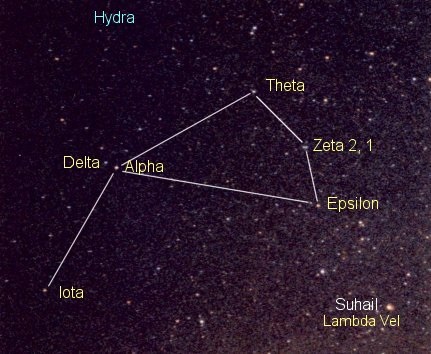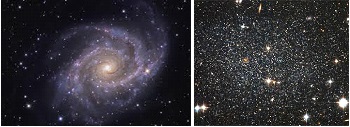
Most of the constellations are seen and discovered in the sky. They are bright and are sometimes easily recognized. However, there is a constellation that was created from an undesignated region of the sky. This is the reason that the stars comprising it are faint. It is the constellation Antlia. A small and faint constellation in the southern hemisphere of the sky, Antlia was introduced by Nicolas Louis de Lacaille in the 18th century. Antlia comes from an ancient Greek word that means ‘pump.’ It specifically represents an air pump and is bordered by Hydra the sea snake, Pyxis the compass, Vela the sails and Centaurus the centaur. Antila belongs to the Lacaille family of constellations.It is clearly visible in the month of April. Let us discuss this constellation further.
The word Antlia is a Greek word which means “the pump”; as an honour to Robert Boyle who invented the first air pump. The original name given was Antlia pneumatica, invented by a French physicist.
The stars in Antlia are very faint, it comprises of only one bright and major star and that is, the Alpha Antliae. Though a brightest star in the constellation, it is only a fourth magnitude star. With an apparent visual magnitude which varies between 4.22–4.29, it is about 365 light years distant from the earth. Also, the star is classified as a K–type giant. The other stars include:
- Alpha, a: It is reddish in colour.
- Epsilon Antliae: It is orange in colour and is classified as a K–type giant. It has a magnitude of about 4.51 and is about 700 light years distant.
- Iota Antliae: An orange K–type giant star, it has a magnitude of about 4.60 and is approximately 199 light years distant.
- Theta Antliae: It is a binary star and consists of Theta Antliae A which is a white A–type main sequence dwarf and Theta Antliae B which is a yellow–white F–type bright giant. It has a magnitude of about 4.78.
- Delta Antliae: This too, is a binary star and is approximately 481 light years away. With a magnitude of about +5.57, it is classified as a blue–white B–type main sequence dwarf.

Antlia contains two galaxies, they are:
- NGC 2997: It is a spiral and grand design galaxy and is located approximately 24.8 million light years away. The peculiar characteristic of NGC 2997 is the chain of hot giant clouds of ionized hydrogen that surrounds the galaxy’s nucleus.
- Antlia Dwarf (PGC 29194): It is a spheroid galaxy that was discovered in 1997. Sometimes referred to as the Antlia Dwarf Galaxy, it is located about 4.3 million light years away from the earth. Its magnitude is about 16.2.

This constellation is located in the second quadrant of the southern hemisphere, to the north of the equator of the galaxy and in the south of the celestial equator and lies between the latitudes +45o and –900.
It is one of the smaller constellations in the sky, ranking 62nd in size. Being one of the smallest constellations, it occupies a minimal area of 239 square degrees.
Abbe Nicolas created this constellation for scientific reasons and after scientific instruments; therefore, it does not have any myths or stories related to it.
G Kowledge of | 0 Comments >>
0 Comments
Leave Comment
Your email address will not be published. Required fields are marked.